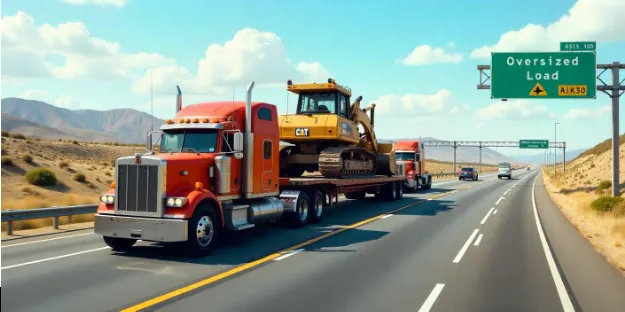How Do I Transport an Oversized Vehicle Across State Lines?

Transporting an oversized vehicle across state lines requires careful planning to ensure safety and compliance with regulations. Whether moving an RV, construction equipment, or a large truck, you need the right permits, transport method, and route planning to avoid delays and fines.
Also Read: Cost-Benefit Analysis of Decking vs. Siding for Columbus Home Improvements
Key Highlights
- Choosing the Right Transport Method – Options like flatbed transport, step-deck trailers, and towing services ensure safe and efficient oversized vehicle transport.
- Legal Compliance & Permits – State and federal laws require special permits and, in some cases, escort vehicles to ensure road safety.
- Cost-Saving Strategies – Flexible scheduling, comparing multiple quotes, and terminal-to-terminal shipping can help reduce costs.
This guide covers essential steps, including choosing the best transport method, obtaining permits, preparing your vehicle, and overcoming common challenges for a smooth and cost-effective move.
What Is an Oversized Vehicle?
An oversized vehicle is any vehicle that exceeds standard size and weight limits set by the Department of Transportation (DOT). These limits may vary by state, but generally, a vehicle is considered oversized if:
- It is wider than 8.5 feet, making it difficult to fit within standard highway lanes.
- It is taller than 13.5-14.5 feet, which may require route adjustments to avoid low-clearance bridges.
- It is longer than 40-53 feet, depending on the type of vehicle, affecting its maneuverability.
- It weighs over 80,000 pounds when fully loaded, requiring specialized transport solutions.
Oversized vehicles require special permits, escorts, and adherence to designated routes to ensure safe transport. Failing to follow regulations can lead to fines or transport delays.
Common oversized vehicles include:
- RVs and motorhomes, which are often too tall or wide for standard transport.
- Construction equipment such as bulldozers, excavators, and cranes, which require flatbed or specialized trailers.
- Large trucks and buses, which often exceed length and weight restrictions.
- Boats on trailers, especially when wider than normal road limits.
Knowing whether your vehicle is oversized helps you plan the right transport strategy and ensures compliance with state and federal laws.
3. Choosing the Right Transport Method
There are different ways to move an oversized vehicle across state lines. The best option depends on your vehicle’s size, weight, and distance of transport.
A. Driveaway Services
This method involves hiring a professional driver to operate your vehicle and transport it to the desired location. It is a great option for drivable oversized vehicles such as RVs and buses. However, this option requires that your vehicle is in good working condition. You also need to account for insurance coverage and fuel costs during the journey.
B. Flatbed Transport
Flatbed trucks are commonly used for oversized vehicles that cannot be driven long distances. These trucks can carry heavy machinery, large trucks, or specialized equipment. Flatbed transport ensures secure oversized vehicle transport over long distances and is one of the most reliable options for oversized vehicles.
C. Step-Deck or Lowboy Trailers
These specialized trailers are designed to accommodate extra-tall or heavy vehicles that may not fit on standard flatbeds. Step-deck trailers have a lower deck, making it easier to transport taller vehicles without exceeding height restrictions. Lowboy trailers are even lower and can accommodate extremely heavy loads, such as construction machinery.
D. Towing Services
For vehicles that are large but still towable, professional towing services can be an efficient method of transport. This option is best for shorter distances and requires additional permits for oversized towing in some states.
Choosing the right transport method ensures safety and compliance with transport laws.
4. Legal Requirements and Permits
Every state has different rules for oversized vehicle transport. You may need special permits to move your vehicle legally.
A. State-Specific Permits
Many states require an oversized load permit, which grants you permission to transport large vehicles on public roads. These permits specify the allowed travel times and routes, ensuring that your oversized vehicle does not interfere with traffic or infrastructure. Some states may also require an escort vehicle, particularly for extra-large loads that require additional visibility and safety precautions.
B. Federal and DOT Regulations
The Federal Motor Carrier Safety Administration (FMCSA) sets safety guidelines for oversized vehicle transport. These regulations ensure that vehicles follow weight and size restrictions, use appropriate safety signs, and travel only during permitted hours. Some highways have special restrictions for oversized vehicles, such as requiring night transport or avoiding certain roads during peak hours. Violating these regulations can result in hefty fines and transport delays.
It is always best to check with each state’s DOT before starting your journey to ensure compliance with permit requirements.
5. Preparing the Vehicle for Transport
Before moving an oversized vehicle, take these steps to avoid problems:
- Inspect the vehicle: Ensure it is in good condition to prevent breakdowns during transport.
- Remove loose parts: Secure or detach any extended parts like mirrors, antennas, or accessories to avoid damage.
- Reduce weight: Remove unnecessary items to lower transport costs and ensure the vehicle meets weight restrictions.
- Take photos: Document the vehicle’s condition for insurance purposes in case of any damage during transit.
Proper preparation prevents damage during transport and helps avoid unnecessary expenses. Many auto transport companies require a pre-transport inspection before loading the vehicle.
Additionally, ensure your vehicle has enough fuel for loading and unloading if using a driveaway service. If your vehicle is not in working condition, inform the transport company in advance so they can arrange for loading equipment.
6. Common Challenges and Solutions
Transporting oversized vehicles comes with challenges, but here’s how to handle them:
A. Route Restrictions
Some roads have low bridges, weight limits, or narrow lanes that may not accommodate oversized vehicles.
Solution: Plan your route in advance with a transport expert who can identify the safest and most efficient roads.
B. Weather Conditions
Bad weather, such as snow, heavy rain, or strong winds, can delay transport and pose safety risks.
Solution: Check weather forecasts before scheduling transport and plan for potential delays.
C. Mechanical Issues
If an oversized vehicle breaks down during transport, it can lead to significant delays.
Solution: Ensure a thorough maintenance check is done before transport to avoid unexpected breakdowns.
D. Traffic and Scheduling
Some states restrict oversized transport to specific hours to avoid high-traffic periods.
Solution: Schedule your transport during permitted hours and avoid peak traffic times.
7. Costs and Ways to Save Money
Several factors affect the cost of transporting an oversized vehicle:
- Distance: Longer trips cost more due to fuel and driver expenses.
- Size and weight: Heavier vehicles require special trailers, increasing costs.
- Permits and escorts: Some states charge higher fees based on vehicle dimensions.
- Fuel prices: Fluctuations in fuel prices impact overall transport costs.
Ways to Save Money
- Choose flexible transport dates: Off-peak times may be cheaper.
- Compare multiple quotes: Getting offers from different transport companies can help you find the best price.
- Use terminal-to-terminal shipping: This option is often more affordable than door-to-door delivery.
8. Insurance and Safety Measures
Protecting your oversized vehicle during transport is crucial. Ensure the transport company provides insurance coverage and verify what is included. Understanding liability and potential compensation for damages will help you avoid financial losses.
Always inspect your vehicle upon arrival and document any damage before signing off on delivery.
Conclusion
Transporting an oversized vehicle across state lines requires careful planning, the right permits, and a reliable transport company. By following these steps, you can ensure a smooth and cost-effective transport experience. Research state regulations, choose the right transport method, and work with an experienced shipping provider to avoid delays or fines.






